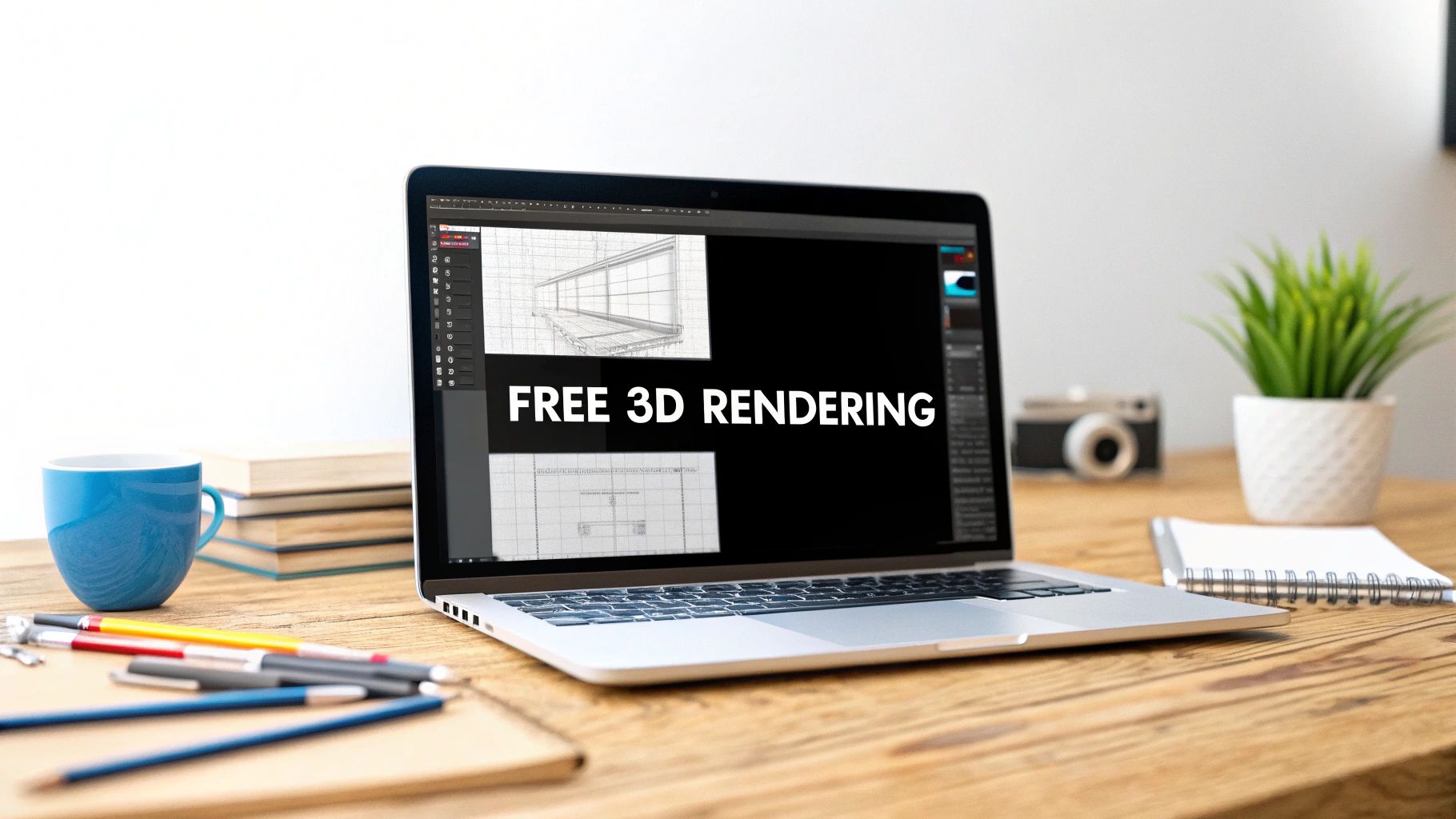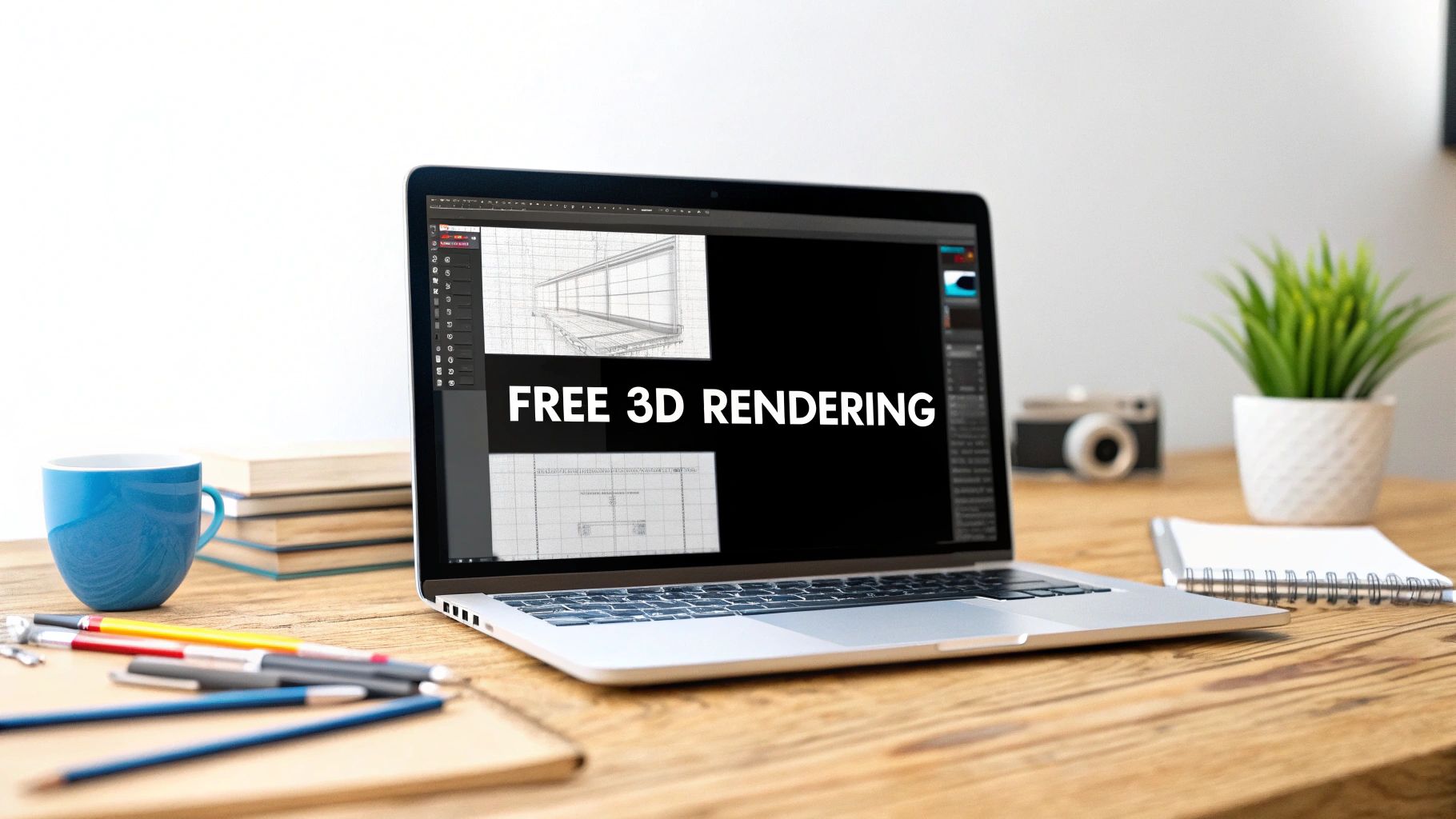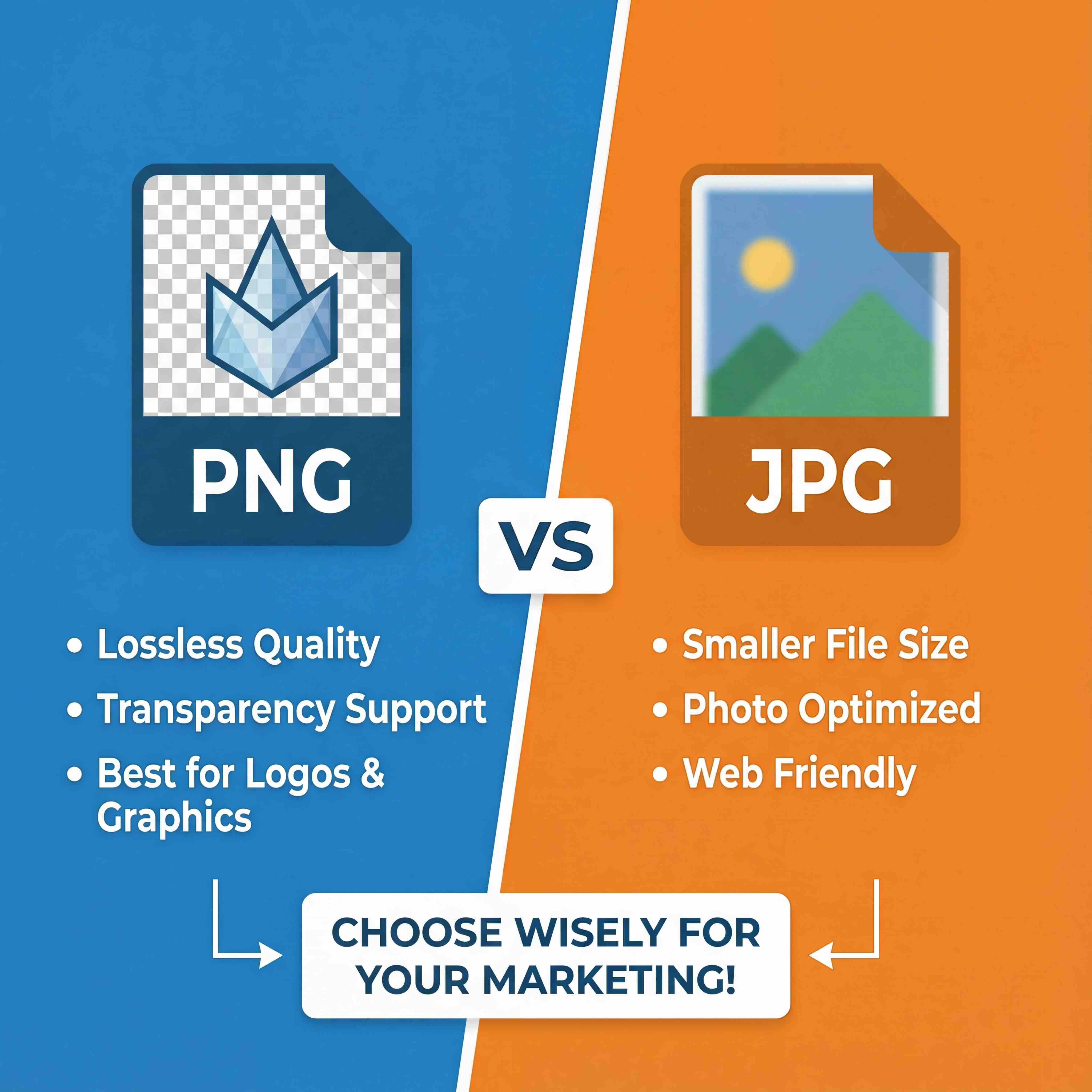Many believe that creating professional-grade renders requires a significant financial investment. This guide aims to show that it is possible to achieve stunning, photorealistic results using powerful software that is available at no cost.
This guide serves as an entry point into the world of industry-grade programs that allow artists, architects, and designers to bring their visions to life—without the financial barrier to entry.
Create Stunning 3D Graphics Without the Cost
The traditional notion that high-quality 3D rendering requires a substantial software budget is outdated. Today, a robust ecosystem of free, open-source, and freemium tools exists, which not only compete with but sometimes even outperform their premium commercial counterparts.
These tools are not just for hobbyists. Professionals in architecture, product design, and entertainment rely on these applications daily for their power and flexibility.
This shift has removed financial barriers, making top-tier visual creation more accessible than ever. It means small studios, freelancers, and even large companies can build efficient, cost-effective workflows. The key is knowing which tools to select and how to integrate them into a professional pipeline.
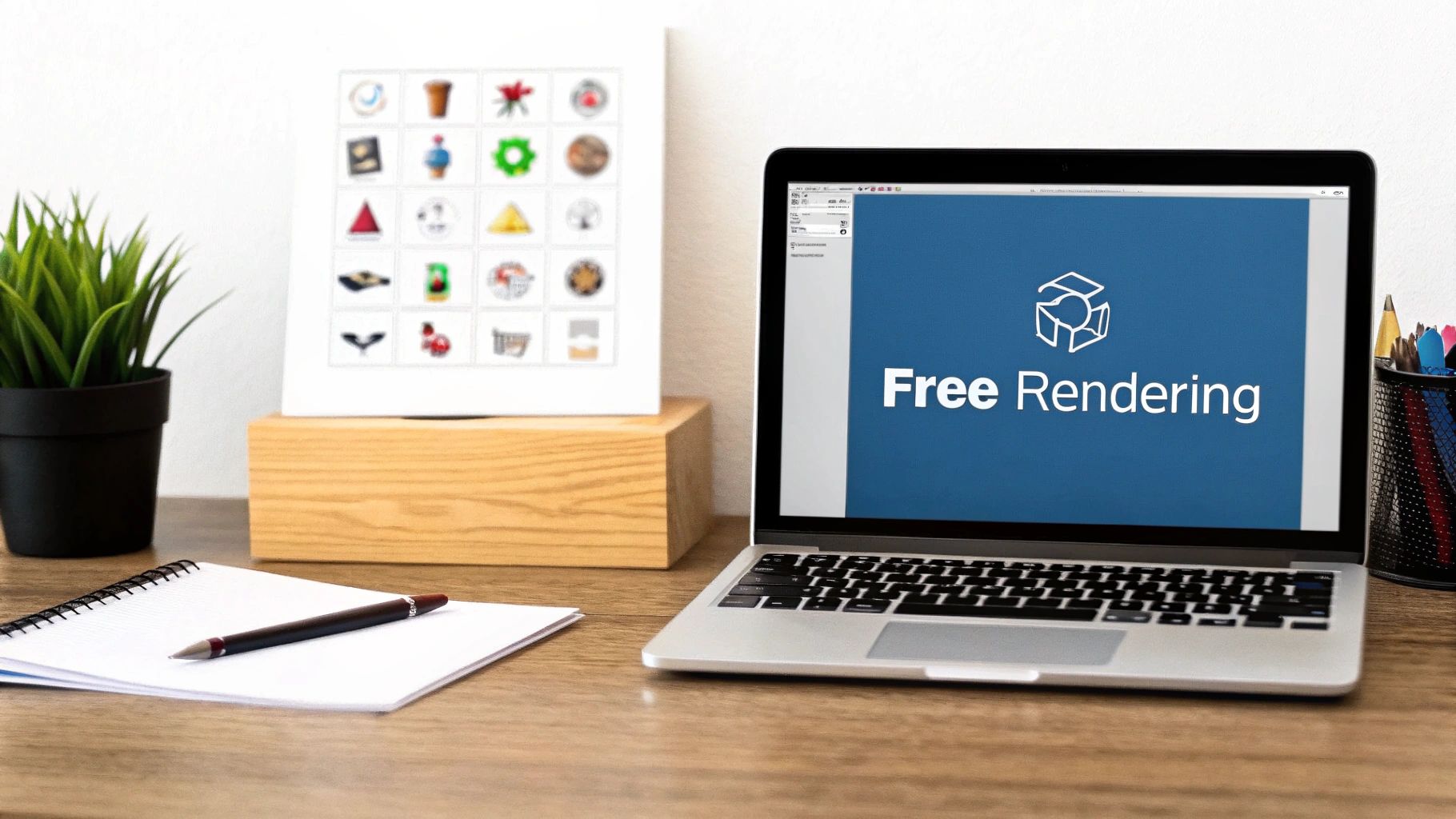
The Growing Accessibility of Rendering Tools
The demand for high-quality 3D visuals has grown exponentially across nearly every industry. This demand is a primary driver behind the creation of better, more accessible rendering solutions.
In fact, the global 3D rendering market is expected to grow from around USD 3.85 billion to USD 23.78 billion between 2023 and 2034. This growth is fueled by sectors ranging from virtual reality and architecture to media and entertainment. You can review the full market projections on 3D rendering growth for a deeper analysis.
This rapid expansion is beneficial for all users. As the market grows, developers are incentivized to create powerful, user-friendly tools they can offer for free, often supported by community donations or optional paid tiers for enterprise features.
For creative teams, this means the barrier to entry is no longer financial—it’s educational. Mastering the right free software provides a significant competitive advantage.
What You Will Learn in This Guide
This guide is designed to provide a comprehensive overview of the best free rendering software available today. We are not just compiling a list; we are providing the context needed to make informed decisions for your projects.
Here’s what this guide will cover:
- Core Rendering Concepts: We will explain technical terms like ray tracing, rasterization, and global illumination in clear, professional language.
- Top Software Options: A detailed review of the leading free tools, highlighting their strengths, best-use cases, and potential limitations.
- Selection Criteria: A practical framework to help you select the right renderer based on your project requirements, hardware, and skill level.
- Professional Integration: Guidance on how to fit these free tools into an intelligent, efficient creative workflow.
Getting to Grips with Key Rendering Concepts
Entering the world of free software for rendering can feel like learning a new technical language. Before you can master any tool, it is essential to understand the core concepts that bring digital images to life. Think of this as your foundational vocabulary—understanding these terms will enable you to compare software intelligently and select the appropriate solution for your work.
At its core, rendering is the process of generating a 2D image from a 3D model. The software functions as a digital camera, calculating light, shadows, and materials to "capture" the final image. This is not a single action, but a complex series of processes working in concert.
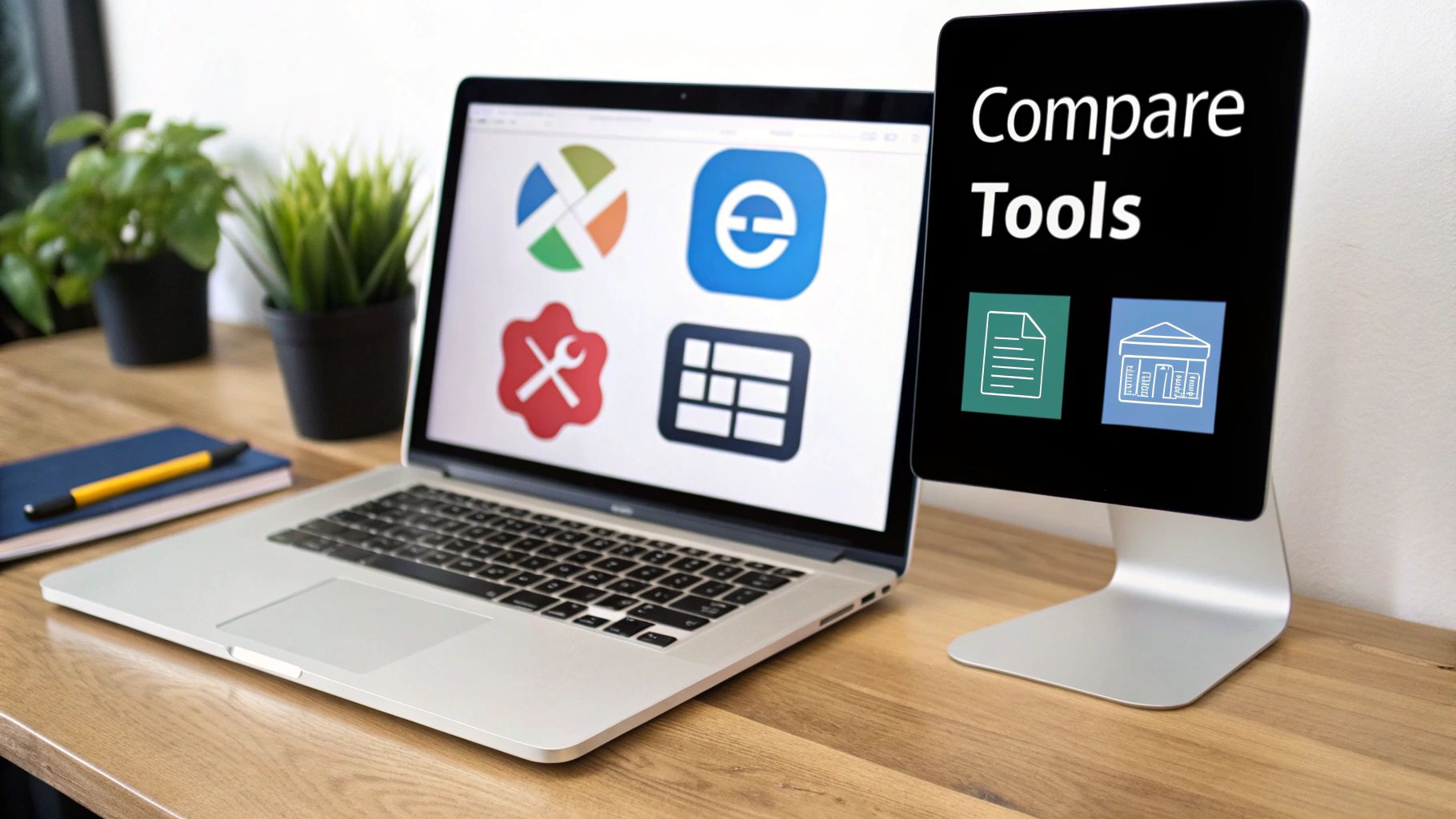
Ray Tracing vs. Rasterization
Two primary methods dominate the rendering landscape: ray tracing and rasterization. Let’s examine them.
Ray Tracing: This method meticulously follows the path of individual rays of light. It tracks how they bounce off surfaces, reflect from mirrors, and cast soft shadows. It is a computationally intensive process that mimics real-world physics to achieve highly realistic results. This is the preferred method for photorealistic architectural visualizations and high-end animated films.
Rasterization: This approach is much faster. Instead of tracking light paths, it projects the 3D objects onto a 2D grid of pixels and then determines the color for each pixel. It is significantly faster than ray tracing, which is why it is the standard for real-time applications like video games, where achieving 60 frames per second is critical.
Many modern renderers—including free options—now use a hybrid approach. They combine the speed of rasterization with select ray-traced effects for elements like reflections or shadows, providing a balance of performance and quality.
Biased vs. Unbiased Rendering Engines
You will often encounter the terms "biased" and "unbiased" when discussing rendering engines. This refers to the methodology—essentially, a choice between computational speed and physical perfection.
An unbiased engine is focused on pure physical accuracy. It simulates light paths with mathematical precision, taking no shortcuts. The result is an incredibly realistic image without digital artifacts, but it requires significantly longer render times. A notable free example that excels at this is LuxCoreRender.
A biased engine, in contrast, uses algorithms to approximate how light behaves, producing a convincing image in a fraction of the time. This is ideal for animations and projects where deadlines are a primary concern.
The choice between biased and unbiased rendering is a classic trade-off. You must decide whether you need perfect, physically accurate lighting for a static architectural render, or fast, high-quality results for a multi-frame animation.
The Building Blocks of a Realistic Image
Beyond the core method, several other key components contribute to the final image. Understanding these will help you configure the settings in any free software for rendering.
Global Illumination (GI): This is a critical element for creating realistic scenes. GI simulates indirect light—the light that bounces off surfaces. It’s the reason a red wall casts a subtle red glow on an adjacent white floor, and why shadows are not simply pitch-black voids.
Shaders and Materials: A shader is a set of instructions that tells the engine how a surface should react to light. It defines whether a surface is shiny like chrome, rough like concrete, or transparent like glass. These properties are bundled into a material, which combines shaders with textures.
Textures: These are the 2D images wrapped around a 3D model to provide surface detail, such as a brick pattern on a wall or a wood grain on a table. Textures add the color, bumps, and imperfections that contribute to the illusion of reality. You can see how all these pieces come together in our guide on the fundamentals of rendering and animation.
Once you understand these concepts, you are no longer just adjusting settings. You are making informed artistic and technical decisions, ready to evaluate different rendering tools and select the one that best fits your vision.
A Closer Look at the Best Free Rendering Software
Exploring the world of free software for rendering can seem daunting, but the landscape is filled with powerful, professional-grade tools. These are complete solutions capable of producing high-quality visuals for architecture, animation, product design, and more.
This guide will go beyond a simple feature list. We will examine the user experience, optimal use cases for each tool, and the associated learning curve. Selecting the right software is about matching its strengths to your creative goals and workflow.
First, let's review what is required to get these tools operational. The infographic below compares key setup statistics like download size and minimum RAM requirements.

As you can see, some tools like Blender have a larger footprint, while others are more lightweight. However, all of them require a reasonably modern system to perform effectively.
Blender: The All-in-One Powerhouse
When discussing free 3D software, Blender is almost always the first name mentioned, and for good reason. It is a complete, open-source 3D creation suite that covers modeling, sculpting, animation, compositing, and rendering. Its greatest strength is its integrated environment, which eliminates the need to switch between different programs.
Blender includes two excellent built-in rendering engines: Cycles and Eevee. This dual-engine setup provides incredible flexibility.

The interface is highly customizable, which is a significant advantage for professionals who want to tailor their workspace for maximum efficiency.
Cycles: For Photorealistic Accuracy
Cycles is Blender's physically-based path tracing engine. It meticulously simulates how light behaves in the real world to create stunningly accurate images. It's the engine to use when details like soft shadows, complex reflections, and subtle light bounces are critical.
- Ideal Applications: Architectural visualization, product shots, and final-frame renders for animated films.
- Strengths: Delivers exceptionally realistic results, supports GPU rendering for faster performance, and features a deep node-based material system for creating any imaginable surface.
- Potential Drawbacks: Because it prioritizes accuracy, render times can be long, especially for complex interior scenes with significant indirect lighting.
Eevee: For Real-Time Feedback
In contrast, Eevee is Blender’s real-time rasterization engine. Eevee is built for speed and instant feedback. It functions much like a modern video game engine, rendering your scene almost instantly. This makes it invaluable for look development, pre-visualization, and stylized animations.
While Eevee does not have the same physical accuracy as Cycles, its speed is transformative for the creative process. It allows artists to adjust lighting and materials in real time, eliminating the traditional "render and wait" feedback loop.
This ability to iterate so quickly is a primary reason why Blender is popular with everyone from solo creators to large studios. Furthermore, the large and active community means you will never be short on tutorials, plugins, and support, which helps mitigate its famously steep learning curve.
LuxCoreRender: The Unbiased Realism Specialist
For projects where absolute, uncompromising physical accuracy is the top priority, LuxCoreRender is an important name to know. It is a purely unbiased, physically-based rendering engine that simulates the flow of light based on real physics. It is open-source and can be used as a standalone tool or as a plugin for software like Blender.
Unlike Blender's all-in-one approach, LuxCoreRender is a specialist—its sole mission is to produce images that are indistinguishable from reality. This singular focus makes it a favorite among architects and designers who need to create truly convincing visualizations.
This dedication to accuracy means it handles incredibly complex lighting situations, such as caustics (the light patterns at the bottom of a swimming pool or through a glass of water), with breathtaking realism.
Key Features and Strengths
LuxCoreRender is built for artists who demand total precision.
- Advanced Material System: It supports a wide range of realistic materials, including physically accurate glass, metals, and subsurface scattering for materials like skin or wax.
- Comprehensive Light Simulation: It can simulate the entire light spectrum, allowing for phenomena like dispersion (the rainbow effect seen when light passes through a prism).
- Denoising Capabilities: Long render times are inherent to unbiased engines, but LuxCoreRender includes powerful denoising tools to help clean up images and achieve a final result faster.
The main trade-off here is speed. This is not the tool for animation or projects with tight turnarounds. However, for a static architectural render where realism is paramount, few free options can match it. The learning curve can also be steep, especially for those new to the concepts of physically-based rendering.
The rise of specialized tools like this is part of a larger trend. The global market for visualization and 3D rendering software—which includes many free and open-source options—was valued at approximately USD 2.20 billion in 2022 and is projected to reach USD 17.38 billion by 2030. That's a compound annual growth rate of 30.6%, demonstrating the significant demand for these tools. You can review the data in this full market analysis on visualization software.
D5 Render: The User-Friendly Real-Time Solution
Now let's shift from pure accuracy to speed and ease of use with D5 Render. Built on Unreal Engine, D5 uses real-time ray tracing to deliver a fast, intuitive, and visually stunning rendering experience. It is aimed specifically at the architecture, interior design, and landscape architecture industries.
Unlike the complex interfaces of traditional 3D software, D5 prioritizes a streamlined workflow, making it an excellent choice for designers who are not 3D experts but still need to produce high-quality renders efficiently.
The entire philosophy behind D5 is to shorten the distance between a 3D model and a beautiful final image. It achieves this by combining real-time feedback with an extensive built-in asset library.
Strengths and Ideal Use Cases
D5 Render is not intended to be an all-purpose tool like Blender. Its focus is narrow but incredibly deep, and that is its greatest strength.
- Ease of Use: The learning curve is significantly gentler than other software on this list. It is possible to achieve impressive results in hours, not weeks.
- High-Quality Asset Library: D5 comes with a large library of models, materials, and particle effects (like rain or fog), allowing you to populate scenes quickly.
- Real-Time Ray Tracing: What you see is what you get. The preview provides a high-fidelity look at your final render, so you can adjust lighting and materials on the fly.
The main limitation is its focus. It is outstanding for architectural visualization but is not designed for character animation or complex VFX. The free version also has some limitations, such as a smaller asset library and resolution caps. But for its target audience, D5 Render offers a remarkably efficient and powerful free software for rendering that balances usability and quality.
To help you decide, here is a quick side-by-side comparison of these top contenders.
Comparison of Top Free Rendering Software
This table breaks down the key differences between the leading free rendering software, so you can see at a glance which one might be the best fit for your needs.
Ultimately, the best choice depends entirely on your project. If you require a versatile tool and are willing to invest the time, Blender is an excellent choice. If you are an architect seeking perfect realism for a still image, LuxCoreRender is your specialist. And if you need beautiful architectural renders quickly without a steep learning curve, D5 Render is a fantastic option.
How to Choose the Right Free Renderer for You
With so many powerful options available, selecting the right free software for rendering can be challenging. However, there is no single “best” tool. The goal is to find the best tool for your specific requirements.
Think of it like choosing a vehicle. You wouldn't use a sports car for moving, and you wouldn't take a large truck to the grocery store. Every renderer is a specialized tool built for a particular purpose. Your task is to match the tool to your project's destination.
Let’s break the selection process down into three simple steps.
Evaluate Your Hardware and Rendering Method
First, it is important to assess your computer's capabilities. Your machine's processor (CPU) and graphics card (GPU) are the most significant factors determining which software will run smoothly.
- CPU Rendering: This method uses your computer's main processor for all rendering calculations. It is highly accurate and can handle large, complex scenes without memory limitations, but the trade-off is speed. It is often much slower.
- GPU Rendering: This leverages the power of your graphics card to accelerate the process, often dramatically. It is ideal for getting fast feedback and iterating quickly, but it is limited by your card's VRAM (video memory).
Take a look at your system configuration. If you have a powerful, modern GPU like an NVIDIA RTX or AMD RX series card, a GPU-based renderer will perform very well. If you are using an older machine or a laptop with integrated graphics, a CPU-based renderer will be a more reliable, albeit slower, option.
Define Your Primary Use Case
Next, consider what you are trying to create. Different renderers are optimized for different types of work. Matching the tool to the task is key to an efficient workflow.
Are you aiming for absolute photorealism for a single, high-impact image? Or do you need rapid previews for an animated short? Your answer will significantly narrow down your list of options.
Here are a few common scenarios to consider:
- Architectural Visualization: If you are creating photorealistic interiors and exteriors, you need an engine that excels at accurate light simulation. Unbiased renderers like LuxCoreRender are built for this kind of precision. Alternatively, tools like D5 Render provide a real-time workflow that is incredibly fast. (Our guide on https://virtuall.pro/blog-posts/software-for-architectural-rendering provides more detail on this topic).
- Motion Graphics and Animation: For animation, speed is paramount. You are not rendering one frame; you are rendering thousands. A real-time engine like Blender's Eevee is a major asset here, providing instant feedback so you can adjust lighting and materials on the fly without lengthy waits.
- Product Design and VFX: This type of work demands flexibility. You need a tool that can handle both realistic materials and complex visual effects. Blender’s Cycles is an excellent all-around solution that strikes a great balance between physical accuracy and creative freedom.
Assess Community and Ecosystem Support
Finally, never underestimate the power of a strong community. A large, active user base means more tutorials, forums for assistance, and a wealth of free assets to download. This is a significant factor, especially when you are starting out. Blender, for instance, has one of the largest and most helpful communities in the 3D industry.
It is also wise to look beyond the renderer itself. For example, learning how to choose the best video editing software for beginners offers a similar lesson: a tool is only as good as the support and resources surrounding it.
A rich ecosystem of plugins can extend a renderer's capabilities, connecting it to other software in your pipeline. This ensures the tool can grow with you as your skills develop and your projects become more ambitious.
Integrating Free Renderers Into Your Workflow
A great tool is only as good as its fit within your creative process. Switching to free software for rendering does not require you to completely overhaul your existing workflow. It is about intelligently integrating it into the pipeline you already have.
Establishing this connection correctly is the key to building an efficient, professional workflow that brings your vision to life without costly interruptions.
The journey from a blank canvas to a finished image almost always follows the same path, beginning with your 3D models.
From Modeling to Rendering
Every 3D project begins with asset creation. This is where you build and assemble the objects for your scene, typically within dedicated modeling software. Most artists and studios already have their preferred tools for this stage.
You might be using Blender for its comprehensive feature set or a program like SketchUp for architectural mockups. If you are looking for options, our guide to the best free 3D modeling software is a great place to start.
Once your models are complete, the next challenge is importing them into your chosen renderer with all details intact.
A seamless workflow is not about finding a single tool that does everything. It’s about building a solid bridge between specialized tools, ensuring data flows from modeling to texturing to rendering without friction.
This is where some technical knowledge is beneficial. To ensure different applications can communicate effectively, the 3D industry relies on a few standardized file formats.
The Role of Common File Formats
Think of file formats as the universal language of 3D. Selecting the right one ensures your model’s geometry, textures, and other essential data are transferred from your modeling program to your renderer without any loss of information.
You will frequently encounter these two formats:
- FBX (.fbx): Developed by Autodesk, this format is a true industry standard. It handles not just geometry but also animation data, materials, cameras, and more. For complex, animated scenes, FBX is typically the preferred choice.
- OBJ (.obj): As one of the oldest formats, OBJ is a reliable workhorse of the 3D world. It is perfect for transferring static models and basic material information. It's simple, robust, and supported by nearly every 3D application available.
By exporting your work as an FBX or OBJ, you are creating a portable, future-proof asset that can be used in almost any free rendering software.
Connecting Your Tools with Plugins
For an even more integrated and fluid workflow, many standalone renderers offer plugins that connect directly to your modeling software. This creates a "live link" between your tools.
These add-ons allow you to send your entire scene to the renderer with a single click, eliminating tedious manual exporting and importing. This significantly accelerates the iteration and creative exploration process.
This trend toward connectivity is happening everywhere, especially with the growth of cloud-based tools. The global cloud rendering market is expected to reach USD 16.75 billion by 2034, with the media and entertainment sector accounting for nearly 35% of that demand. You can find more insights on the future of cloud rendering on market.us. This trend highlights the industry's shift toward faster, more connected workflows—a movement in which free tools play a significant part.
Got Questions About Free Rendering Software?
Exploring the world of free rendering tools often brings up a few questions. Whether you are a freelancer, running a small studio, or part of a larger team, getting clear answers is essential. Let’s address the most common ones so you can proceed with confidence.
Consider this a practical, straightforward guide to help you make informed decisions.
Can I Actually Use Free Software for Commercial Work?
This is a critical question, and the short answer is: yes, in almost all cases. The key lies in the software license.
Most of the leading free rendering tools, like Blender, are open-source. They are often released under licenses such as the GNU General Public License (GPL), which explicitly grants you the freedom to use the software for any purpose—including paid client projects. You can create commercial art, sell your renders, and build a business around it without any software licensing costs.
That said, it is always a responsible practice to review the license for any tool or add-on you download. A quick look at the terms of service ensures compliance and helps you avoid potential legal issues.
What Am I Giving Up Compared to Paid Tools?
While free software is incredibly powerful, there are a few trade-offs when compared to premium commercial packages.
- Dedicated Support: Paid software usually includes access to a professional support team. With free tools, support comes from the community—forums, Discord channels, and online groups. This support is often excellent, but an immediate, guaranteed response is not always available.
- Out-of-the-Box Polish: Commercial tools sometimes offer more polished features or large, professionally curated asset libraries that are ready to use from day one.
- Niche Workflows: Some highly specialized industries rely on commercial software built for very specific tasks, with features that may not yet be available in free alternatives.
The core rendering quality of top-tier free software often matches or even exceeds that of paid alternatives. The primary differences are usually in the surrounding ecosystem—things like enterprise-level support and ready-made integrations.
What Kind of Computer Do I Need to Start?
You do not need a supercomputer, but your hardware will significantly impact your rendering speed and overall experience. The two most important components are your graphics card (GPU) and your processor (CPU).
A modern GPU with at least 8 GB of VRAM is a solid starting point for taking advantage of fast GPU rendering. If you are relying on your CPU, more cores will dramatically reduce your render times. For system memory, aim for at least 16 GB of RAM to handle scenes of moderate complexity without performance issues.
How Long Does It Take to Get Good at Blender?
Blender has a reputation for a steep learning curve, but it is incredibly rewarding once mastered. A dedicated beginner can learn the fundamentals—navigating the interface and creating simple renders—in just a few weeks.
However, reaching a professional level where you can confidently handle any project typically requires several months to a year of consistent practice. The good news is the massive community and endless free tutorials make that learning process faster and more accessible than ever before.
Ready to build your next 3D masterpiece? Virtuall helps creative teams accelerate their workflows by generating high-quality 3D models from simple text and images. Our platform is built for collaboration, giving your team the tools to manage projects and create stunning assets faster than ever before. Explore the future of 3D creation at Virtuall.pro.

